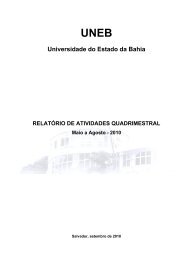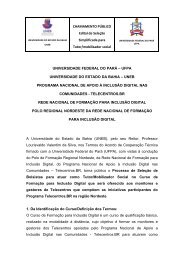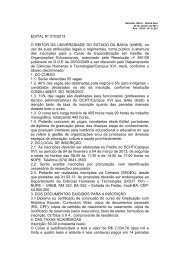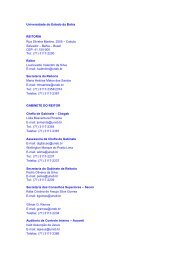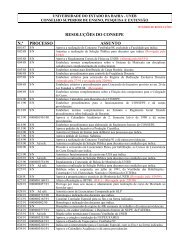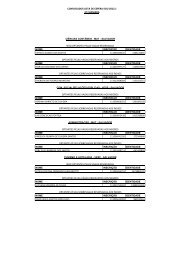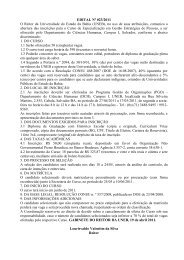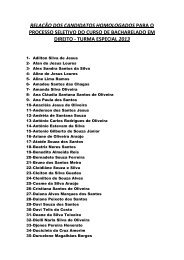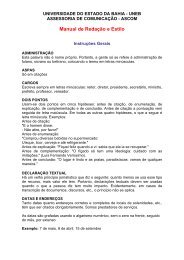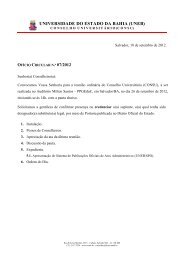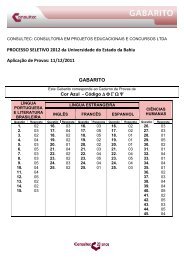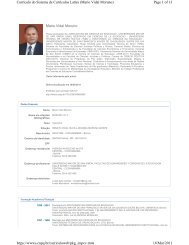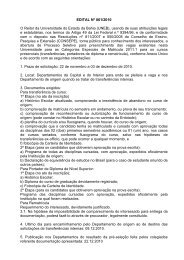Revista da FAEEBA Educação e Contemporaneidade - Uneb
Revista da FAEEBA Educação e Contemporaneidade - Uneb
Revista da FAEEBA Educação e Contemporaneidade - Uneb
You also want an ePaper? Increase the reach of your titles
YUMPU automatically turns print PDFs into web optimized ePapers that Google loves.
EDITORIAL<br />
Education, Art and Ludicity is the theme of the number 25 of the <strong>Revista</strong><br />
<strong>da</strong> <strong>FAEEBA</strong> – <strong>Educação</strong> e Contemporanei<strong>da</strong>de. Without any doubt, it will let<br />
a mark in this journal’s history, not only for the new theme embraced and for<br />
its importance and scope but also for the significant contribution of the GE-<br />
PEL – Grupo de Estudos e Pesquisas em <strong>Educação</strong> e Ludici<strong>da</strong>de from the<br />
UFBA. We open this way a new framework of scientific cooperation, this<br />
time with an universitary institution outside the UNEB but from the same city<br />
(Salvador). We hope that it may constitute the beginning of a fertile academic<br />
exchange with other institutions, in and out of Bahia, possibilitating a greater<br />
integration between education research groups.<br />
All the texts aim at showing the vital importance of art and ludicity within<br />
the process of educational practices, in a formal or larger context. The first<br />
paper, from Cristina Maria D’Ávila, analyses present practices and shows the<br />
overdimensioned role of the di<strong>da</strong>ctic book which obliterate a ludic, pleasurable<br />
and creative pe<strong>da</strong>gogy. In this sense, Maria José Etelvina dos Santos investigates<br />
ludic activities as resources from the educational practice focussing on<br />
the pupil emotional development. From her part, Nilce <strong>da</strong> Silva points out some<br />
necessary characteristics for the elaboration of XXIst century pe<strong>da</strong>gogy based<br />
upon creativity.<br />
Follow various texts relating fieldworks upon the theme. Ilma Maria Fernandes<br />
Soares explains the teachers’ beliefs about ludicity and playful activities,<br />
which, in a certain way, explain the teachers’ resistance to a work framed<br />
by ludicity. From her part, Sueli Barros <strong>da</strong> Resssureição shows the importance<br />
of lucidity in professional education within the affective involvement and reenchantment<br />
of teachers’ work. Next paper, from Rilmar Lopes <strong>da</strong> Silva tells<br />
about a pe<strong>da</strong>gogical experience of Theater Education which aims at education<br />
citizens able to be creative, critic, participative and autonomous. Ricardo Japans<br />
analyzes in a detailed way, the infantile plastic and graphic development<br />
and the teachers’ education in the teaching of art in the first years of primary<br />
school.<br />
Ilene Ancient Cana<strong>da</strong>’s paper describes the importance of ludicity during<br />
the conscientization process of young and adult while learning how to read and<br />
write. Finally, Susana Couto Pimentel discusses the potentiality of games in<br />
the promotion of learning processes and special students’ development.<br />
The third section gives a special attention to Art, in the words of Miguel<br />
Almir Lima de Araújo, onthologic expression of the human condition, with its<br />
potential of transfiguration of the real through our blatant sensibility and imagi-<br />
<strong>Revista</strong> <strong>da</strong> <strong>FAEEBA</strong> – <strong>Educação</strong> e Contemporanei<strong>da</strong>de, Salvador, v. 15, n. 25, jan./jun., 2006 11



